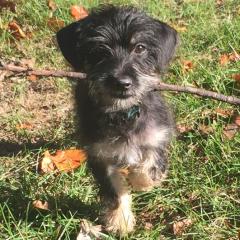Does Your Dog Eat Sticks, Too?

It's fall, the leaves are falling, and branches are falling along with them. Rusko absolutely loves to grab those branches, twigs, and sticks while we’re outside on our walks. Within minutes of relieving himself, Rusko has a stick for me. Sometimes he wants to play fetch. Sometimes he just wants to chew it. I’ve always thought it was cute, but while I was watching him chomp on a stick the other day, I remembered something I read about online. It seems harmless, but it turns out that stick chewing can be dangerous.
Willow, a Saint Bernard puppy in Billings, Montana, swallowed a 14-inch stick whole, and ended up in a life-threatening situation. Willow’s mom, Marissa, didn’t know the stick had been eaten until she started seeing a strange symptom: Willow was yelping when she was eating. Two vet hospitals, many tests, x-rays, medications, and visits later, a veterinary specialist found the stick lodged in Willow’s throat while using an endoscope.
Sure, it’s an extreme story, but Willow’s story is just one of many, where a dog has eaten an object outside. In addition to sticks, Rusko and my new puppy Jax have been known to go for rocks, acorns, pinecones, and even flower bulbs. They’re all tempting things to chew and play with!
So, how can you prevent your pup from eating sticks, rocks, acorns, or pinecones the next time you go to play in the yard? I played around with what works for my dogs to stop them from going for stuff outside, and came up with the following tricks:
- Use a leash when walking your dog outdoors. A leash gives you more control over where your dog goes and what he puts in his mouth. I keep Jax on the leash, even at the park, and will keep doing so until I know he listens to me a bit better.
- Teach your dog to “drop it” using a better reward like your pet’s favorite treats every time your dog picks up a stick or other object that he shouldn’t. Rusko listens to me very well, so he has learned to drop whatever is in his mouth the second I say it.
- “Leave it” is another good command to teach. You’d use this to stop your dog from even picking up the object in the first place. I’m working on this, but it’s a little harder to do. What seems to work best is for me to take something very tempting, like Rusko’s favorite tennis ball, and roll it slowly in front of him. If I say “leave it” and he doesn’t go for it, he gets a yummy treat!
- Be more actively engaged with your dog while you’re outside. Nothing works better than getting your dog’s mind on something else! I taught my dogs to play fetch with appropriate toys like dog tennis balls (regular tennis balls designed for the sport contain dangerous chemicals to help them bounce) and actively engage with them while they’re outdoors. It works wonders to keep their minds off chewing and eating other things!
The above tips have worked wonders for my dogs, but in severe cases, a basket muzzle can be used. You’ll need to practice getting your dog used to a muzzle gradually and for short periods of time, but these can prove incredibly useful if your pet is too quick to grab and swallow things for the above methods to work.
Keeping sticks, rocks, acorns, and other objects out of my dogs’ mouths when we’re outside will keep them out of surgery, so it’s worth putting in the training effort!

